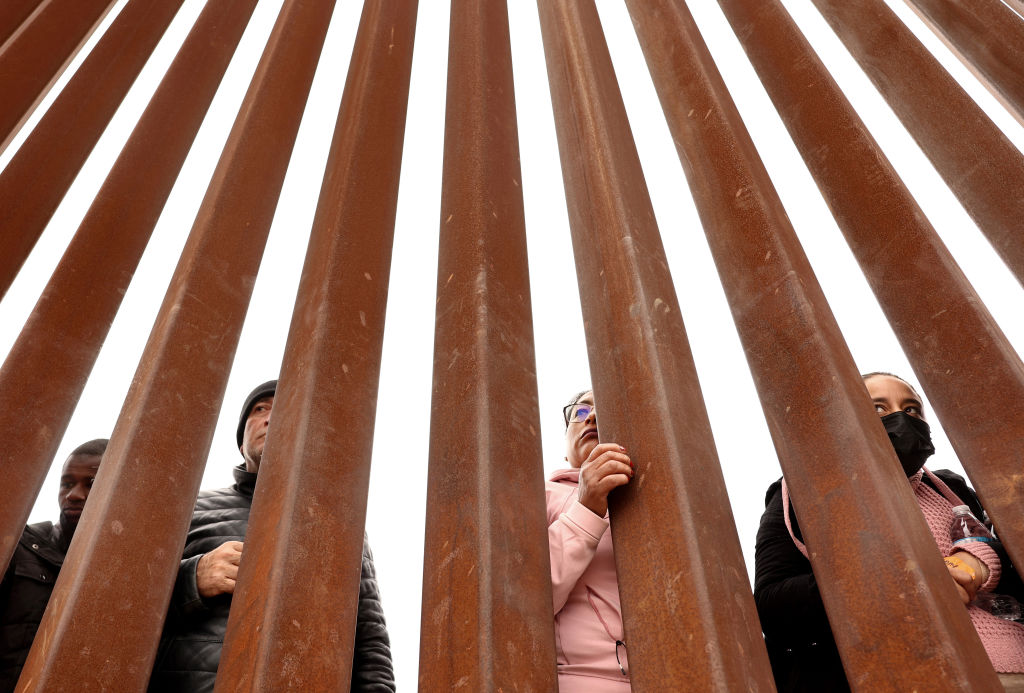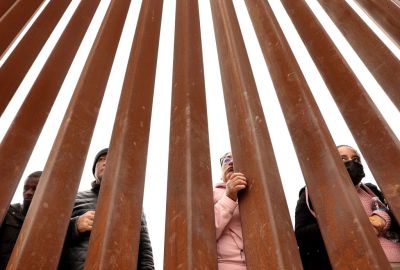Former President Donald Trump didn’t take the debate stage last week, but his immigration policy stances still made the rounds online after Axios reported the details of his expected approach to immigration if he retakes the White House. If enacted, the plan would place unprecedented restrictions on immigration.
What’s in Trump’s plan?
Trump, according to Axios, would complete the wall on the U.S.-Mexico border, expand Texas’ floating buoy barriers in the Rio Grande, designate drug cartels as “unlawful enemy combatants” to give the U.S. military the greenlight to target them in Mexico, and involve agencies other than U.S. Customs and Immigration Services (such as the FBI, the Drug Enforcement Agency, and the National Guard) in the detention and deportation of anyone who immigrated illegally. He also wants to send the U.S. Coast Guard and Navy to form a blockade to deter drug smuggling boats in U.S. and Latin American waters.
The plan would also curtail access to legal immigration pathways, via increased ideological screening, screening on wealth, and country of origin. He would also restrict asylum, and would reinstate his “Remain in Mexico” policy, which required people to wait in Mexico for their asylum cases to be adjudicated in the United States. And he seeks to expand it by negotiating deals with Guatemala, Honduras, and El Salvador to send people from those countries back there instead of allowing them to seek asylum in the United States. He would also use the vague threat of various illnesses to reimpose Title 42, a COVID-19-era public health order that swiftly ejected border crossers back to Mexico rather than processing their asylum claims or enrolling them in formal deportation proceedings.
“Trump’s immigration campaign promises are no surprise,” David Bier, associate director of the Cato Institute’s Immigration Studies tells The Dispatch. Bier contends that most of the ideas are “performative” and won’t actually address immigration problems: “Nothing in his plan addresses the basic fact that illegal immigration is caused by the fact that legal immigration is impossible for most people. In fact, his plan would only exacerbate this problem.”
A few policies seem particularly contentious.
Ending birthright citizenship.
Trump recently pledged on his campaign website to sign an executive order on the first day of his administration to end birthright citizenship. Doing so would also end the practice of some women traveling to the United States on a nonimmigrant tourist visa to give birth and secure U.S. citizenship for their children.
The order will make it “clear to federal agencies that under the correct interpretation of the law, going forward, the future children of illegal aliens will not receive automatic U.S. citizenship,” he said.
Trump has long had a bone to pick with birthright citizenship, which allows the children of those who came illegally to the United States to obtain U.S. citizenship. He told Axios in 2018 he planned to sign an order ending the provision then. Yet he never did.
“It was always told to me that you needed a constitutional amendment. Guess what? You don’t,” he said five years ago. “Now they’re saying I can do it just with an executive order.”
In 2018, John Eastman, the attorney who pushed a dubious legal plan to keep Trump in power following his 2020 election loss, was among some who argued that the 14th Amendment has been interpreted wrongly since its 1868 passage. The line in the 14th Amendment that says “subject to the jurisdiction thereof” should be interpreted to mean people who are citizens, he told Axios.
In the recent announcement, Trump said the order would “explain the clear meaning of the 14th Amendment, that U.S. Citizenship extends only to those both born in AND ‘subject to the jurisdiction’ of the United States.”
But many legal scholars, including conservatives like Judge James C. Ho, a Trump appointee to the 5th Circuit Court of Appeals, have argued the amendment is rightly interpreted to encompass those who have a legal obligation to follow U.S. laws. Ho wrote in a 2006 law review article that opponents of the 14th Amendment at the time of its passing understood it would extend U.S. citizenship to groups they deemed undesirable, including Chinese laborers and other noncitizens. Subsequent Supreme Court rulings have bolstered this interpretation, declaring that the children of legal residents are citizens and carving out limited exceptions, such as the children of foreign diplomats or those belonging to hostile armies.
“Opponents of illegal immigration cannot claim to champion the rule of law and then, in the same breath, propose policies that violate our Constitution,” Ho wrote.
Wielding the Alien Enemies Act.
Trump also plans to use a subsection of the Alien and Sedition Acts of 1798 to rapidly deport members of gangs or cartels, smugglers, and others convicted of crimes. This would happen by declaring unauthorized crossings at the southern border as an “invasion” and saying that people from certain countries are designated as “alien enemies.”
This would allow the administration to circumvent the legal process followed by Immigration and Customs Enforcement (ICE) and skip straight to deportation.
That one also faces scrutiny: “The United States isn’t at war,” Bier says, explaining that using the Alien Enemies Act to deport people is not possible without the contingency of war.
More ideological screening.
The plan also calls for increased ideological screening for applicants for legal immigration.
U.S. immigration law makes anyone who has an affiliation with the “Communist or any other totalitarian party” inadmissible to the United States. During and after World War I, Congress passed a series of laws, starting with the Immigration Law of 1918, designed to “protect the United States against un-American and subversive activities that were considered threats to national security,” according to U.S. Citizenship and Immigration Services. These laws created the basis for detaining, deporting, registering, identifying, and tracking members of communists or totalitarian parties. Later amendments specified that “only membership or affiliation which was voluntary would be considered for exclusion,” and included exceptions for membership obtained in order to secure basic living essentials like employment or food rations, involuntary membership, or membership that had terminated at least five years before application for U.S. citizenship.
Trump wants to use that statute to reject applicants for legal immigration if they are designated “Marxists.”
But the question is how that would work practically. “He can’t use a statute that is for people who are members or affiliated with the Communist Party to exclude people just with Marxist beliefs however defined,” Bier says.
While Trump’s plans would undoubtedly face legal challenges, the U.S. Supreme Court cemented a conservative majority during his administration and, at times, has been deferential to the executive branch’s ability to set federal immigration policy. Most recently, the Supreme Court sided with the Biden administration’s immigration deportation priorities.
The first iteration of Trump’s administration used executive orders, presidential proclamations, and department policy guidance changes to enact nearly 500 administrative changes to overhaul the U.S. immigration system, according to the Migration Policy Institute. Those included limiting both legal immigration and asylum as well as hollowing out the U.S. refugee program. Despite this flurry of activity, much of his plan remained unenacted.
Trump leaned on top adviser Stephen Miller to craft those sweeping immigration policies in this first term. Miller was quick to celebrate the proposed changes, saying they would meet his longtime goal of clamping down on all immigration. “The 2025 crackdown will bolt the hatches faster than a thunderclap and tighter than a submarine,” he said.






Please note that we at The Dispatch hold ourselves, our work, and our commenters to a higher standard than other places on the internet. We welcome comments that foster genuine debate or discussion—including comments critical of us or our work—but responses that include ad hominem attacks on fellow Dispatch members or are intended to stoke fear and anger may be moderated.
With your membership, you only have the ability to comment on The Morning Dispatch articles. Consider upgrading to join the conversation everywhere.